Baudoinia Compniacensis
Published August 14, 2020

What is Baudoinia Compniacensis?
Baudoinia Compniacensis is a sac fungus (Ascomycota) that has been observed on a variety of natural substrates near distilleries including soil, rock and vegetation, as well as bonded warehouses, and nearby street signs. The fungus is a habitat colonist with a preference for airborne alcohol.
Controvertial Neighbours
In recent years the Baudoinia fungus has made newpaper headlines, as the fungus don’t limit their growth to the distilleries and warehouses. Baudoinia growth is not restricted to nutrient-rich or mineral substrates such as brick or wood. It can also be found on the metal bodies of cars, fences and traffic signs; often for more than a mile from the source of the alcohol. The smeary, sooty, black film on cars, houses and also garden furniture in the vicinity of the distilleries has led to numerous recent legal challenges.
This problem is not new, because Baudoinia compniacensis has been around for a long time, significantly longer than humans. The Baudoinia fungus is most likely completely harmless to humans, but its spores - as with so many other types of fungus - are found almost everywhere. Its discovery goes back to the French pharmacist Antonin Baudoin, who was amazed as early as 1872 by the black surfaces on buildings of distilleries near the French city of Cognac. Even then, the Baudoinia grew on walls, roof tiles, tree trunks and fences.

A Resurge In Interest
After the fungus was almost ignored scientifically for more than a century, it moved back into the public eye at the end of the last century. The reason, however, was not the Baudoinia itself, but health problems associated with the growth of dark fungi in buildings whose structure had become damp due to water damage. As a result, the large-scale occurrence of soot-like fungus growth on buildings and objects around distilleries has again became an issue arousing attention.
In this context, it was rediscovered that the Baudoinia fungus, thrive where the air is humid and contains a particularly large amount of alcohol, the so called angels’ share. Nowadays, however, this no longer only applies to the area around distilleries of whiskey or cognac, although the phenomenon of discoloration is also often referred to as ‘warehouse staining’ or ‘whiskey black’. In the extended circle of popular growing areas there are also bakeries, which indicates a further affinity of the fungus with regard to natural fermentation processes, and with the addition of ethanol in the vicinity of car fuels stores.
Brandy distilleries in California have got Baudoinia Compniacensis under control by equipping their distilleries with devices to break down the ethanol into water and carbon dioxide and thus starve the fungus. Several lawsuits have occured in Scotland and the US in an attempt to push whisky distilleries to take similar steps, Diageo has claimed in court that this has a negative effect on the flavour of the nearby maturing whisey. Brandy manufacturers like E & J Gallo contradicted this however.
References
- Couple take legal action against Diageo over whisky fungus
- The Dark Side of the ‘Angel’s Share’
- Kentucky’s Whiskey Fungus Problem Is Out of Control
FAQs
Why do whisky distilleries cause black fungus?
Whisky distilleries cause black fungus to grows in the surrounding area of their maturing wearhouses because Baudoinia Compniacensis feeds on the vapours of the alcohol maturing. This black fungus can appear as a result of natural fermentation processes in bogs, natural composts or near seasonal fruit environments but is more widespread around whisky wearhouses due to the volume of available food.
Is Baudoinia Compniacensis harmful?
Although unsightly Baudoinia Compniacensis is believed to be completely harmless to humans. While several lawsuits have been raised about the grimy soot left on buildings the spores are not a threat to the structural integrity of buildings either.

